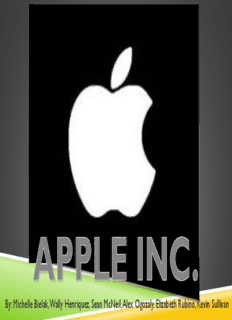
By: Michelle Bielak, Wally Henriquez, Sean McNeil, Alex PDF
Preview By: Michelle Bielak, Wally Henriquez, Sean McNeil, Alex
By: Michelle Bielak, Wally Henriquez, Sean McNeil, Alex Ogozaly, Elizabeth Rubino, Kevin Sullivan APPLE INC. PARENT COMPANY OVERVIEW Name: Apple Incorporated Location: Cupertino, California CEO/ President: Steven Paul Jobs Company Annual Revenue: $65.2 billion (Fiscal year ended September 2010) Number of Employees: 49, 400 Employees (Fiscal year ended September 2010) Type of Business: Electronics, Entertainment APPLE’S MISSION STATEMENT “Apple designs Macs, the best personal computers in the world, along with OS X, iLife, iWork, and professional software. Apple leads the digital music revolution with its iPods and iTunes online store. Apple reinvented the mobile phone with its revolutionary iPhone and App Store, and has recently introduced its magical iPad which is defining the future of mobile media and computing devices.” PARENT ORGANIZATION CHART Company CEO President Steven Jobs Hong Kong Our Business Milano Italy, VP: Headquarters, China, VP: John Unit, New Pascal Cagni California, USA Brandon Delhi India Customer Sales Marketing Products Finance Service Educational Music Electronics Programs for Games Software Engineering children/ adults GOALS IN THE NEXT TWO-YEARS Company Annual Revenue: Increase revenue with new products and updated product to 65million Number of Employees: Increase the number of employees in all departments and expand the number of Apple Inc. stores location wide The main concern of Apple in 2011 is to be environmentally safe Apple’s Strategic Positioning: High Valued Electronics at a High Price Reduced Costs Increase Profit, reduce costs Maximize Shareholder Value Profitability Enter New Markets Add Value and Raise Prices Enterprise Valuation Sell more in existing Markets Profit Growth Enter New Markets LABOR LAWS “Workmen’s Compensation Act, 1923” “Payment of Wages Act, 1936” “The Industrial Disputes Act, 1947” “The Minimum Wages Act, 1948” “The Maternity Benefit Act, 1961” “Payment of Bonus Act, 1965” “Payment of Gratuity Act, 1972” FINANCIAL LAWS AND REGULATIONS The Reserve Bank of India “Banking Regulation Act, 1949” Banking Companies Bill passed on August 9, 1969. India Accounting Standards SEBI established in 1988. INDIA LAW Structure of the Indian Judicial System Supreme Court, High Court, Courts of Civil Jurisdiction. Based off of English common law. Criminal law in India based on the Indian Penal Code. Supreme Court recently grants right to counsel on February 24, 2011. Important to consider Hindu Law in India. IMPORTANT ASPECTS OF INDUSTRY AND GEOGRAPHY Price lower with cheap labor Will population want to purchase our products? Indian Ocean Great trade opportunities 77% of trade done by sea
Description: